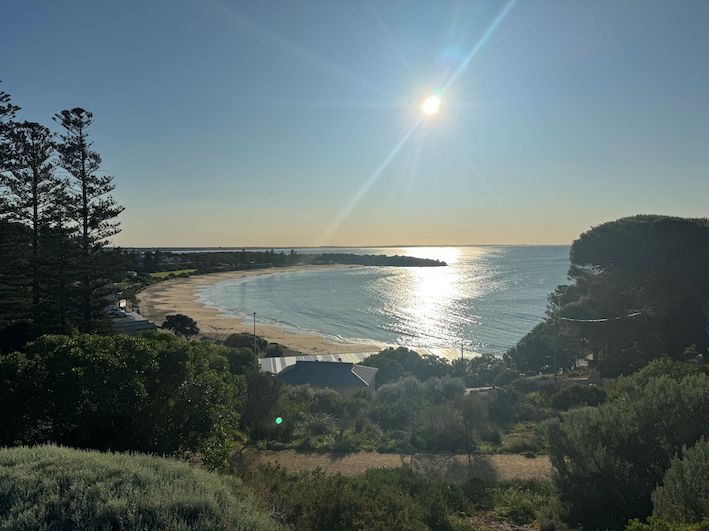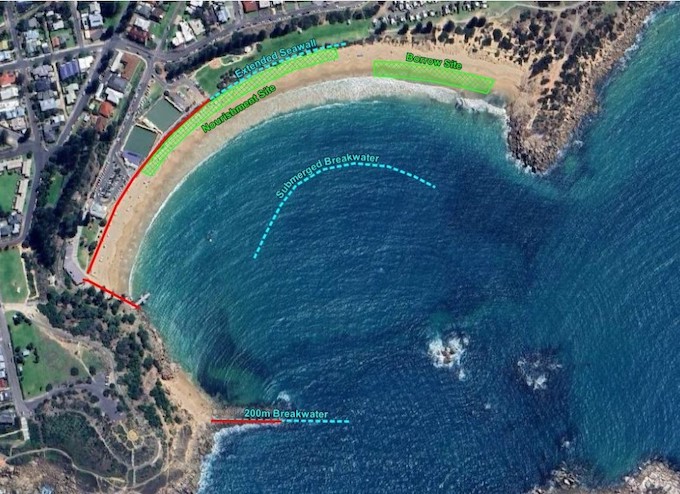Coastal defence plan for Horseshoe Bay
Staff Reporters
17 September 2025, 9:14 PM
 Horseshoe Bay. Image courtesy of Alexandrina Council.
Horseshoe Bay. Image courtesy of Alexandrina Council.Mitigation options to address the potential impact of rising sea levels on public infrastructure in Port Elliot’s popular Horseshoe Bay, including sand replacement or a new sea wall, will be presented to the Alexandrina community for feedback from next week.
Alexandrina Council says scientific studies and recent analyses of wave modelling data collected in the bay last year indicate that the shoreline in the middle of Horseshoe Bay is forecast to recede by around 12 metres by 2050.
By 2100, that forecast is expected to be 25 metres, which could place the structural integrity of structures such as the Port Elliot Bowling Club, the Flying Fish Cafe, the Surf Life Saving Club, carparks, footpaths, toilets, and reserve areas at risk.
The forecast is based on the South Australian Coast Protection Board’s adopted sea level rise along Alexandrina’s 26 kilometres of coastline.
Alexandrina Council received a $112,500 Federal Government grant to conduct wave modelling analysis and other surveys after Horseshoe Bay was identified as a priority action area in their Coastal Adaptation Study conducted in 2021.
Other action areas in the study were the Mundoo and Goolwa Channels, where the flood risk from seawater storm surges was identified as a top priority.
In response, the council worked with the channel communities in 2024 to prepare a Community Coastal Flood Emergency Plan.
“Council has been working hard to identify the impacts of climate change on our community and to take strategic priority actions to make ourselves more resilient,” Mayor Keith Parkes says.
“The wave modelling study at Horseshoe Bay was the next step in tackling the priority actions identified in our 2022 Coastal Adaptation Plan.
“The results from the experts in this field of science show no easy answer in terms of effectiveness and cost, and they all have social, environmental, and cultural trade-offs.
“Beach erosion is a natural event. Rising sea levels exacerbate that in certain areas, such as Horseshoe Bay, which is one of the most popular beach destinations in our community and the state and consequently has a lot of man- made infrastructure.
“Our consultants have presented us with some options and given their expert opinion on the value, impacts, and effectiveness of each option.
“Now we want to get our community’s opinion. However, I do want to stress the final decision-maker in all of this is the Coast Protection Board, who have ‘power of direction’ which means they can approve, refuse, or ask for changes to any proposal that the community and Council put forward as preferred options.
“We invite the community to consider the options put forward during our consultation period, which runs from 25 September until the end of October.
“You will be able to see the options on our My Say community consultation website when consultation opens, as we’re also hoping to have an information stall at the Port Elliot Show on 11 and 12 October, so come along and talk to our Planning Team.”
The consultants Cape Advisory identified five options for mitigation (with two variations), including:
• Raising the breakwater height and length.
• Constructing a submerged breakwater - nature-based or artificial reef – in the near shore, with or without sand nourishment.
• Sand nourishment only (from the eastern side of Horseshoe Bay or from external sources).
• Replacing and extending the existing seawall.
• Managed relocation of assets.

Image courtesy Consultants Cape Advisory, showing five options considered.
The consultants advised that sand nourishment, seawall replacement and extension with sand nourishment, and managed relocation of assets were the most viable options to mitigate risk.
Raising the height and length of the breakwater was considered the most expensive, most challenging for construction and development approvals and the least likely to mitigate the longer-term impact of sea level rises.
Managed relocation of built assets would effectively mitigate the hazard, would allow natural processes to proceed in the bay and would promote flora and fauna values.
It was the option considered the most challenging to implement due to the potential impacts on community infrastructure. The bay may still require protection beyond the year 2100.
Community consultation on the options will open on Next Wednesday 25 September and close on 30 October. For details visit the council My Say page or the council offices.